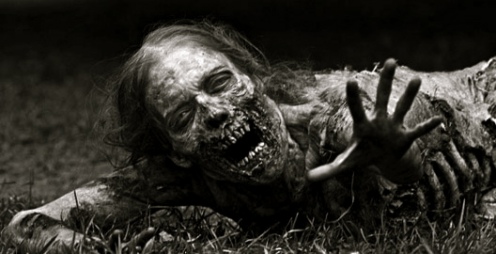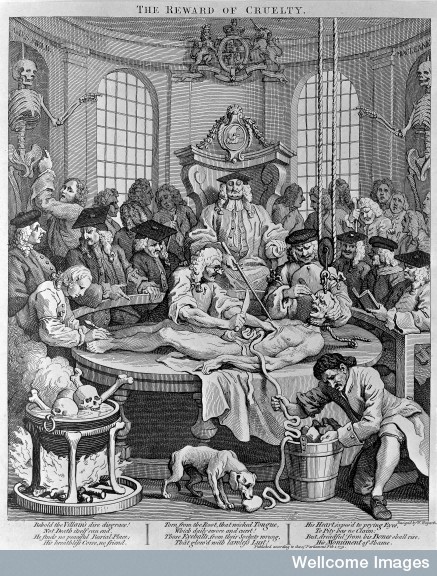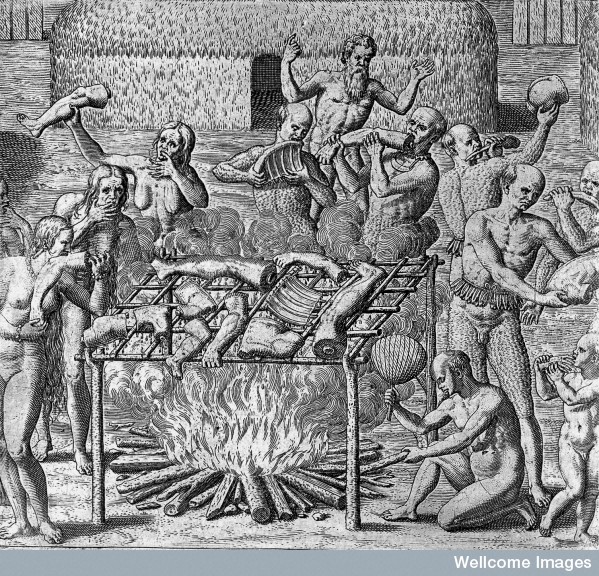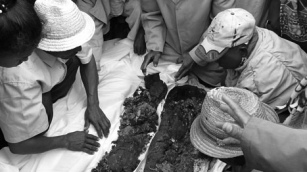The Order is thrilled to have our first guest post from our friend and death academic from across the pond, Lindsey Fitzharris. She received her PhD in the History of Science, Medicine and Technology from the University of Oxford in 2009. She is currently a Wellcome Trust Research Fellow at Queen Mary, University of London. She runs a website on the history of pre-anaesthetic surgery, The Chirurgeon’s Apprentice, and is writing a book on the history of anatomy through stories of criminal dissection.
*~*~*~*~*~*~*~*~*~*~*~*~*~*~*

Up until the last decades of the 19th century, people living in Derbyshire, England meticulously collected and stored their fallen or extracted teeth in jars. When a person died, these teeth were placed inside the coffin alongside the corpse. On Judgment Day, those who failed to do this would be damned to search for the lost teeth in a bucket of blood located deep within the fiery pits of Hell. [1]
Today, beliefs such as this may seem peculiar and quaint to a culture that has effectively banished the dead to the outskirts of society. Where once the corpse of a loved one was caringly washed by family members and laid out reverently in the home, it now is ‘injected, packed and placed in a coffin to prevent odours and the spread of germs’ by mortuary technicians. [2]
A dead body has become an offense to the living. It is contaminated, unhygienic, a potential source of disease. Moreover, it is a reminder of our collective mortality and in this sense, it must be shut away. Even when a body is displayed at a funeral, great efforts are made to return the corpse to a ‘natural’ state in which the dead look like the living despite the fact that the natural state of a corpse is putrefaction and decay.
Above all, death has come to be seen as ‘an impassable barricade that [precludes] interaction with those on the other side.’ [3] Yet, it was not long ago that the boundaries between the living and the dead were believed to be much more transient and fluid than they are today.
On 14 February 1829, the Morning Herald reported a story about a woman who had recently died and been buried in a village near Mansfield in Nottinghamshire. Before dying, she had asked a close friend that the letters of her dead son be placed in the coffin beside her body after she had died. The friend—distraught by the woman’s eventual death—forgot to do this and became very distressed after the funeral. Fortuitously, the village postman died a few days later and the woman arranged to have the letters put into his coffin, as ‘she firmly believed that he would be as diligent a postman in the other world as he had been in this.’ [4]

Stories like this help us to understand why people in the past feared the anatomist’s knife so much. Deliberate mutilation of the body in this life could have dire consequences for a person in the afterlife. Most people imagined the dead to have an active, physical role in the next world, whether this occurred immediately after death or on the Day of Judgement. For many living in earlier periods, dissection represented ‘not only the exposure of nakedness’ and disrespect towards the dead, but also the ‘destruction of [one’s] identity, perhaps for eternity.’ [5]
But preserving the body for the Resurrection was only one reason why people sought to avoid ending up on the surgeon’s dissection table. Unlike most Britons today—whom view death as an irreversible finality—many people in the past believed the corpse retained power, or even vitality, shortly after dying. This was especially true of a person whose life was cut short prematurely.
For instance, it was widely thought that the hand of an executed criminal could cure a variety of ailments—ulcers, scrofula, cysts and even goitres. As soon as the victim had been pronounced dead, a crowd of people would surge forward to touch the cooling hand of the corpse dangling from the noose. Similar beliefs surrounded the blood of those unfortunate souls who lost their heads on the scaffold. Many people gathered close to catch the hot liquid as it spurted from the severed arteries of the neck; the blood was then drank, hot and thick, by epileptics hoping desperately to cure their debilitating and misunderstood disease. [For more on medicinal cannibalism, click here].

Nothing was spared when it came to the corpse of a criminal—the fat was especially prized by surgeons in the early modern period. According to one contemporary, Richard Wiseman attributed ‘the cure of a lady, whose legs were swelled and schirrious…chiefly to the parts being embrocated twice a day with clarified human fat.’ [6] Stories such as this were not unique. In 1736, a woman in Norfolk sold the corpulent body of her executed husband to a surgeon for half a guinea—a considerable sum in 18th-century England. [7]
Even the severed heads on Tower Bridge were employed for medicinal purposes. In the 16th century, a number of German workers working at the Royal Mint in London fell suddenly ill (likely from the exposure to copper fumes). According to some beliefs, drinking from a cup made from a human skull could have miraculous therapeutic effects. With this in mind, the heads from Tower Bridge were removed, the flesh boiled off, and the skulls fashioned into drinking vessels for the immigrant workers. As expected, some of the men recovered but many of them died. [8]
Thus, a dead body took on a ‘life’ of its own. It was imbued with powers that could cure the sick and help prolong the life of those still living. For this reason, many people believed it was abominable to dissect, or waste, a perfectly consumable corpse for anatomical purposes.

Nowadays, our relationship with the dead is very different. This is not to say, however, that these attitudes are universal. In some parts of the world, the boundaries between life and death are far more fluid. The dead are not always ‘dead’ in the way we might understand it in our own culture. In Madagascar, for instance, people exhume their dead relatives, rewrap their remains in fresh grave clothes and dance with them around their tombs in a centuries old ritual known as ‘Famadihana,’ or the ‘Turning of the Bones’ [see illustration at left]. This custom is based on the belief that the spirits of the deceased only enter the world of their ancestors after the corpse is fully decomposed. A similar ritual takes place each year on the second of November in the Christian city of Pomuch, Mexico, where family members gather together to wash the bones of their dead relatives.
But for most people living in Britain [And America! -Mortician’s Note] today, these rituals seem far removed from our own understanding of death. For us, the dead are dead, and anything which suggests otherwise is the product of the overactive imaginations of writers and movie-makers.
Or, of course, the past.
1. Sydney Oldall Addy, Household Tales with Other Traditional Remains (1895), p. 33. 2. ‘Laws and Regulations on the Disposal of Human Remains’. 3. Paul Koudounaris, The Empire of Death: A Cultural History of Ossuaries and Charnel Houses (2010), p. 10. 4. Ruth Richardson, Death, Dissection and the Destitute, 2nd edn. (2000), p. 4. 5. Ibid., p. 29. 6. Richard Guy, An Essay on Scirrhous Tumours, and Cancers (759), pp. 20-1. 7. Richard Sugg, Mummies, Cannibals and Vampires (2011), p. 234. 8. Cited in Alan Brooke and David Brandon, London: The Executioner’s City (2006), p. 11.
***
This article originally appeared on The Chirurgeon’s Apprentice.
